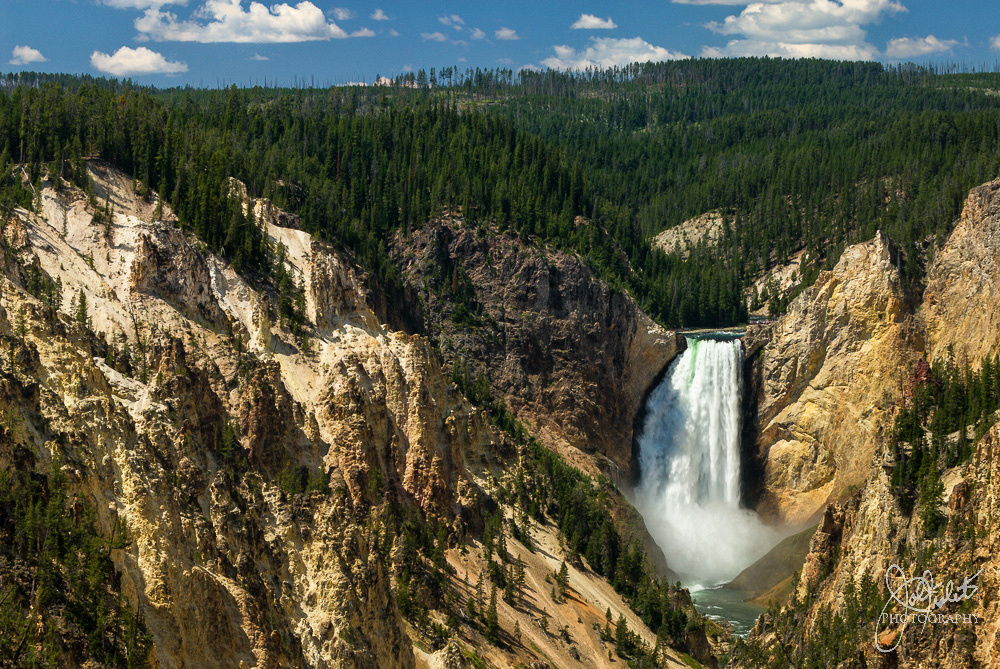Photographing Yellowstone Falls, Yellowstone National Park
Yellowstone Falls is one of the most photographed locations in Yellowstone National Park. This view is from Artist Point overlook. It's my favorite view. There's no need to hike around the lookout for great photos. The primary variable is weather and light. Use a polarizer to bring out the richness of the colors. The tones in the rocks, trees and water also make this a great black-and-white location.
This is also the perfect place to use a spot meter. I used the Sekonic L-758DR to spot meter off of the brink of the falls and open up 2.8 stops, plus polarizer compensation, to open the highlight and capture the full range of values in the scene. I can also use the light meter to meter the shadows and check the dynamic range of the scene to be sure it falls within the camera's range.
It might be to your surprise that even most scenes like this, with such bright highlights, are within the dynamic range capabilities of any DSLR. I've tested this theory with several scenes, including waterfalls in bright sun, and most scenes in daylight have about 5 to 6 stops of dynamic range. But to capture that range you must meter and expose precisely. Without testing, you can be sure that your DSLR captures at least 5 total stops of brightness. Only calibrating can give you an exact number, and that's done with the Sekonic L-758 and included DTS software.
It doesn't matter how you arrive at your correct exposure, but nothing gives you as exact information as a hand-held spot meter. Trusting the meter and knowing that I preserved the highlight and the shadows fell within the range of the sensor enabled me to get the exact exposure in one shot, so when I pressed the shutter I knew I was getting exactly what I wanted, and I was able to develop the negative to its fullest potential in software (Lightroom and Nik Collection). Without precise exposure tools and skills, you're just guessing.
This is my first interpretation of the negative, and part of the joy of photography will be going back several times, as Ansel Adams loved to do, to reinterpret the negative. Amazingly, I've seen no other shots like this. Most place the falls dead center and are not well exposed or developed. With this composition I wanted to almost de-emphasize the falls so that the eye sweeps the more majestic vista before landing on the falls and its plume of mist. Sometimes you make a great thing greater by emphasizing the scale of the environment around it. One gets a sense of the falls' size and power by using the environment as a scale clue. Of course, this one would be best viewed as a 20-by-30 master print, available for sale soon in my upcoming Tetons-Glacier-Yellowstone gallery.
Photo captured with a Nikon D200, Nikkor 70-200 f/2.8 VR, Manfrotto carbon fiber, MC-36 cable release, exposure set to f/16 @ 1/20, ISO 100 for maximum quality. To learn more about landscape photography, check out Joel's workshop and mentoring.
Comments
|
January
February
March
(4)
April (4)
(2)
May (2)
(2)
June (2)
July
August
(2)
September (2)
(1)
October (1)
(2)
November (2)
(4)
December (4)
|
(7)
January (7)
(5)
February (5)
(4)
March (4)
(3)
April (3)
(5)
May (5)
(4)
June (4)
(6)
July (6)
(9)
August (9)
(1)
September (1)
(1)
October (1)
(4)
November (4)
December
|
(3)
January (3)
(1)
February (1)
(1)
March (1)
(3)
April (3)
(1)
May (1)
June
(1)
July (1)
(3)
August (3)
(1)
September (1)
October
November
December
|
January
(1)
February (1)
(1)
March (1)
April
(1)
May (1)
(2)
June (2)
July
(6)
August (6)
(4)
September (4)
October
(3)
November (3)
(1)
December (1)
|
(2)
January (2)
(1)
February (1)
(1)
March (1)
(1)
April (1)
(1)
May (1)
June
(2)
July (2)
(1)
August (1)
(7)
September (7)
October
November
(1)
December (1)
|
(2)
January (2)
February
March
(1)
April (1)
May
(1)
June (1)
July
August
September
October
November
December
|
January
February
March
April
May
June
July
August
September
October
November
December
|
January
February
March
April
May
June
July
August
September
October
November
December
|
January
February
March
April
May
June
July
August
September
October
November
December
|
January
February
March
April
May
June
July
August
September
October
November
December
|
January
February
March
April
May
June
July
August
September
October
November
December
|
January
February
March
April
May
June
July
August
September
October
November
December
|



